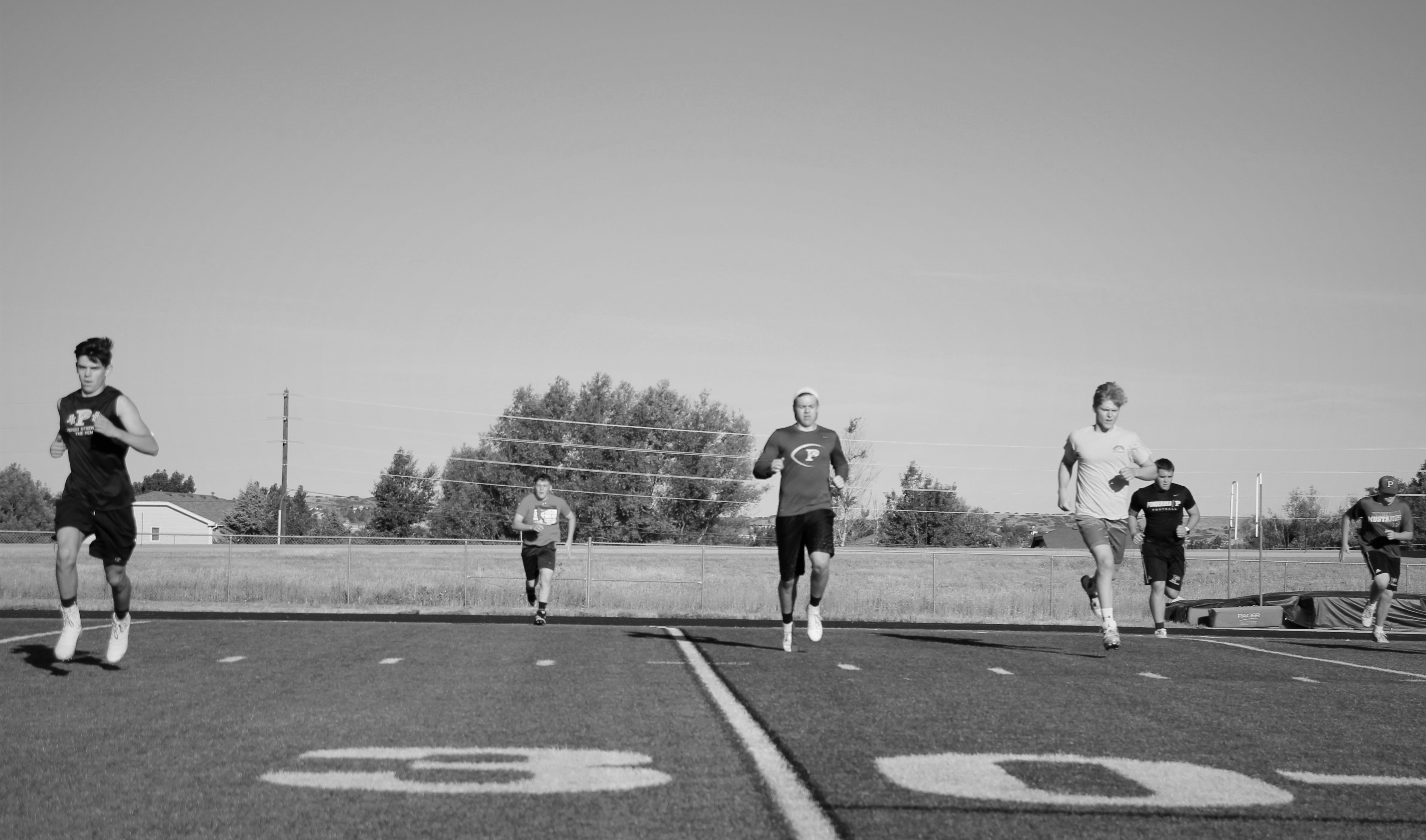Want the Best In Season Workouts for Football? Focus on the Recovery Protocol
Recovery | Sports PerformanceABOUT THE AUTHOR

Rob Van Valkenburgh
Rob Van Valkenburgh joins the TrainHeroic blog with 10 years experience in the strength game. Having coached elite athletes in both the private sector and the Division 1 collegiate setting, Rob believes that strength has to be the foundation of all athletic movement and that athletes of all levels deserve a comprehensive strength program. Rob writes regularly on his own website FootballStrengthCoach.com where here shares short form articles, training tips & programs, and other items related to strength and performance for football.
“If my mother put on a helmet, shoulder pads, and a uniform that wasn’t the same color as the one I was wearing, I’d run over her if she was in my way. And I love my mother.” – Bo Jackson
//The Best In Season Workouts for Football Start with Recovery Training
Recovery training is vital to the long term success of any football organization. With this in mind we will cover how to structure the best in season workouts for football.
Football is a physical and violent game. However, the fast and aggressive nature of it takes a toll on your body unlike any other sport. And, my friends, that controlled violence is one of the things that makes it great.
But, the end result of all the collisions, impacts, and repeated max effort plays is a beaten down body. As any football player can attest to, by the middle of the season you feel like you have been hit by a freight train. If you wake up on a Saturday or Sunday morning and feel fresh then my guess is you either don’t play much or you’re a kicker.
So, what can you do to make sure that your body is at 100% by the next game?
Well, in addition to a smart in-season lifting program, you can follow a recovery protocol that is designed to allow your body to heal up, restore its range of motion, and work through any nagging aches and pains.
This is important because it allows you greater durability, longevity, and better overall athletic performances.
Here is my approach to structuring the best in season workouts for football:

Three points to hit for the best in season workouts
There are a couple things that we need to cover in order to have the best in season workout for football recovery training.
- You need to get the body’s core temperature up before starting the session. Let your perspiration be the guide with the notion of – “If you’re sweaty you’re ready.”
- We need to have a structured progression through this workout. Just like with a lifting session were we hit our power lifts followed by our strength movements, with this we will follow this specific progression.
- Blood Flow
- Activation & Stability
- Mobility
- Soft Tissue Work
- Nervous System Reset
3. Pre, during, and post workout hydration is vital. If we do this right you are going to sweat, a lot. So replacing your hydration levels becomes very key. Not to mention it’s just smart to be hydrated early in the week during the season.
Crafting Effective In Season Workouts for Football
Ok, let’s dig into how we will approach this…
As described above we have to follow an in season football workout that will allow for the most effective recovery session. For this workout we have the goal to be done in 45 minutes. This means we don’t have much time to small talk or catching up on the game last week. Here is quick chart that shows the ideal progression for a recovery workout to achieve the best in season workouts.

Now, let’s go over each block with a sample program.
Your Title Goes Here
Your content goes here. Edit or remove this text inline or in the module Content settings. You can also style every aspect of this content in the module Design settings and even apply custom CSS to this text in the module Advanced settings.
Blood Flow Warm Up:
- Goal: Increase core temperature to prime the body for the upcoming workout. This increased core temperature will allow for a much more effective mobility focused training session as well as to help remove some of the soreness in the body.
- For this you want to look for simple and low impact ways to get the body warm. In the team setting I’m guessing that having everyone on spin bikes in not an option and I don’t want running to be the method used here. So, what we are going to do is use 3-4 dynamic stretches in combination with some light running mechanic drills.
Sample In Season Workout:
- Inchworms X 10 Yards
- Hop-Hop Drops X 15 reps
- Worlds Greatest Stretch X 10 Yards
- Push Up + Push Back X 15 Reps
- Light A-Skips X 10 Yards
- Wide Mountain Climbers X 5 each way
- **Repeat this two times
- Total Time: 10 Minutes
Activation & Stability:
- Goal: Activate muscles in areas that take the largest amount of impact during the season. For football we focus on the knee, hip, and shoulders.
- By activating all the small intrinsic muscles in commonly injured areas we do two things: First, we force blood flow into the region which helps remove metabolic waste-product. Second, we make sure those intrinsic muscles remain strong and active during the season when the overall time in the weight room is greatly decreased. To accomplish this we will use primarily banded movements and C.A.R.’s (Controlled Articular Rotations)
Sample In Season Workout:
- Spanish Squat 2X15
- Lateral Band Walks 2X15 each direction
- Side Lying Adductors 2X15 each leg
- Kneeling Hip C.A.R. 2X5 each side
- Banded Cuban Press 2X15
- BlackBurn (shoulder C.A.R.) 2X15
- **Do this in a circuit fashion with the a moderately high tempo.
- Total Time: 10 Minutes
Mobility:
- Goal: Restore range of motion that has been limited due to fatigue, muscle tightness, and overuse during the previous week.
- Mobility is one of the hidden causes of many soft tissue injuries. With a consistently high volume of use muscles and joints can begin to lose their previous levels of mobility. This causes everything from changes in stride length, vertical jump ability, and rotational power. We are going to use a joint by joint approach for this by working from the big toe up to the shoulder. This circuit we will be performed barefoot and start on the ground.
Sample In Season Workout:
- Big Toe Push Backs X 10
- Kneeling Ankle Mobility X 10 each side
- Active Straight Leg Raise X 10 each side
- Triple Flexion Squat X 10
- Hip Rockers X 5 each side
- Kneeling Hip Flexor Stretch X 10 each side
- Quadruped T-Spine X 10 each side
- Standing Chest Opener X 10 each side
- Shoulder C.A.R. X 5 each side
- Total Time: 10 Minutes
Soft Tissue Work:
- Goal: Reduce muscle tension and increase muscle length to finish out the recovery training protocol.
- This is the official beginning of the cool down phase for this training session and the second to last station in the workout. For this we will use a foam roller and a lacrosse ball as our primary tools. The goal here is to trace over all the major muscles of the body for about 30 seconds per area. As you perform this be on the lookout for ‘hot spots’ or areas that cause pain. This is where you want to focus your attention because that pain sensation is your body telling you there is an issue in that area that needs to be addressed.
Sample In Season Workout:
- Foam Roll Calves X :30 seconds each side
- Foam Roll Hamstrings X :30 seconds each side
- Lacrosse Ball Glutes X :30 seconds each side
- Foam Roll Low Back X :30 seconds
- Form Roll Lat’s X :30 seconds each side
- Foam Roll Quads X :30 seconds each side
- Foam Roll Hip Flexors X :30 seconds each side
- Foam Roll IT Band X :30 seconds each side
- Total Time: 10 Minutes
Nervous System Reset:
- Goal: Calm the body and allow the athlete to return to a parasympathetic or recovery state.
- This may be the most important phase of this whole training session. The nervous system reset is vital because athletes are constantly in a sympathetic (fight or flight) state and this allows them to take a few moments to unwind and send themselves back into a normal nervous system state. For this I take a minimum of five minutes. We always begin with box breathing and finish with simple deep breaths.
Sample In Season Workout:
- Get into a wall stretch position with your legs at 45degrees. Putting your legs on a flat bench is also an good option.
- Perform 10 box breaths with a 4-4-4-4 tempo
- Box breathing is a simple breathing pattern that consists of a four second inhalation, four seconds of retention, four seconds of exhalation through the mouth, and finished with four seconds of retention before the next breath.
- To finish the 5 minutes just have the athletes close their eyes and focus on deep breaths that come in through the nose and out through the mouth.
- Total Time: 5 Minutes
Things to Remember
Now, when looking at your full week training schedule, when is the optimal time to implement an in season workout for football like this?
Ideally this is done the day after a game, however, any time outside of 24 hours before competition will work. If you are a program that heavy squats early in the week then this would be a great compliment in the 48 hours after your heaviest lift.
To wrap this up, here are a couple of basic guidelines that are vital to cover….
1: This training should not last more than 45 minutes. In-season workouts needs to be quick and to the point.
2: The movements listed above are simply a recommendation. Don’t be reckless with any of the stretches (i.e. If you feel like you have a pulled groin don’t do the movements that hit the groin.).
3: This can be done up to two times per week, however, make sure to avoid doing this on gameday. Unless, you want a team to run out of the tunnel like they just got done with yoga class.
Creating the best in season workouts for football will always start with a strong recovery protecol. Following these key points will result in you athletes feeling fresh all season.
Are you a better coach after reading this?
More coaches and athletes than ever are reading the TrainHeroic blog, and it’s our mission to support them with useful training & coaching content. If you found this article useful, please take a moment to share it on social media, engage with the author, and link to this article on your own blog or any forums you post on.
Be Your Best,
TrainHeroic Content Team
HEROIC SOCIAL
HEROIC SOCIAL
TRAINING LAB
Access the latest articles, reviews, and case studies from the top strength and conditioning minds in the TH Training Lab

